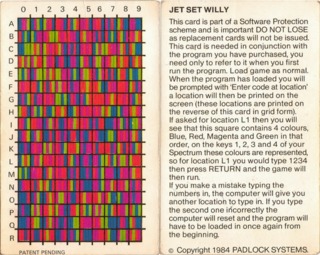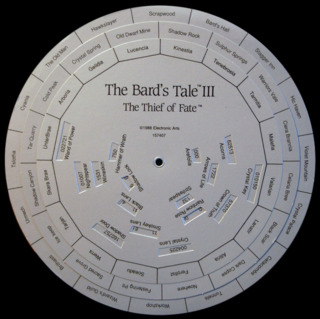Overview
 A color-code copy protection card used in Jet Set Willy.
A color-code copy protection card used in Jet Set Willy.Lore found within instruction manuals and physical packaging was often used as copy protection in the earlier days of PC gaming. At a specific point (or points) in the game, a prompt would appear, tasking the player with a challenge response; e.g., finding a potion recipe in the instructions of Kings Quest 3, or a certain word in a specified paragraph and page in the game's manual. Some schemes used code tables (often printed on colored paper in low-contrast ink to prevent easy photocopying) or multi-color code grids.
 A code wheel required for playing The Bard's Tale III.
A code wheel required for playing The Bard's Tale III.More complex protection methods used a code wheel that was required at certain parts of the game (e.g., when teleporting to a dimension in The Bard's Tale III), or when saving the game. Sometimes the code wheel would contain multiple rotating discs, and also feature multi-colored or low-contrast printing to prevent easy disassembly and photocopying of the device.
 A Lenslok device, folded flat for storage.
A Lenslok device, folded flat for storage.The most elaborate physical copy protection scheme was Lenslok, a folded plastic device containing a transparent, prismatic lens. On loading a Lenslok protected game, a scrambled image was presented; by folding the device and placing it over the image, a two-character code became visible through the lens, which was required to be typed before the game would continue. The image on screen needed to be scaled to correctly to work, and this would cause problems with unusually small or large displays. The device was small enough (when folded flat) to fit next in an audio cassette in a standard case.
Log in to comment